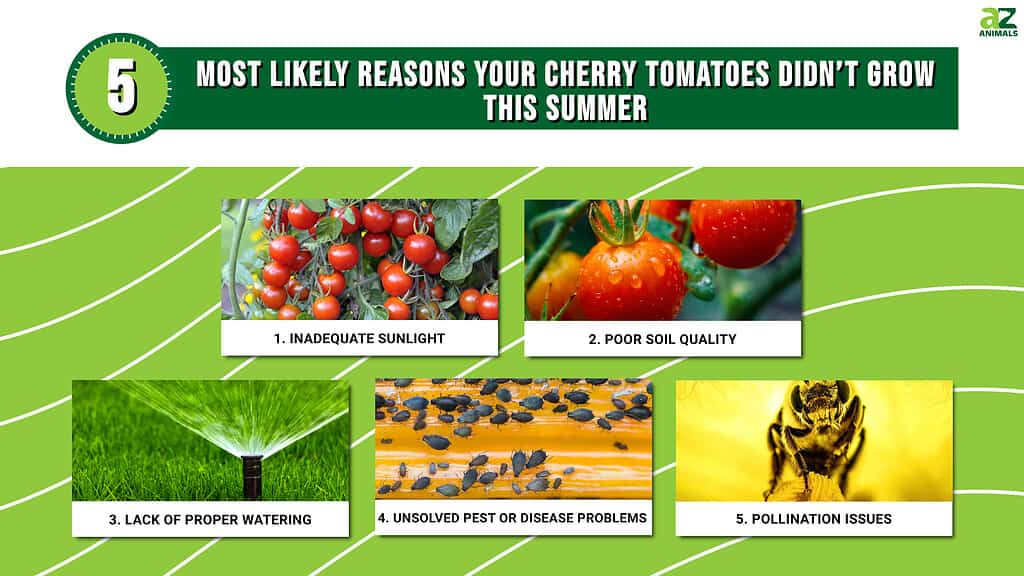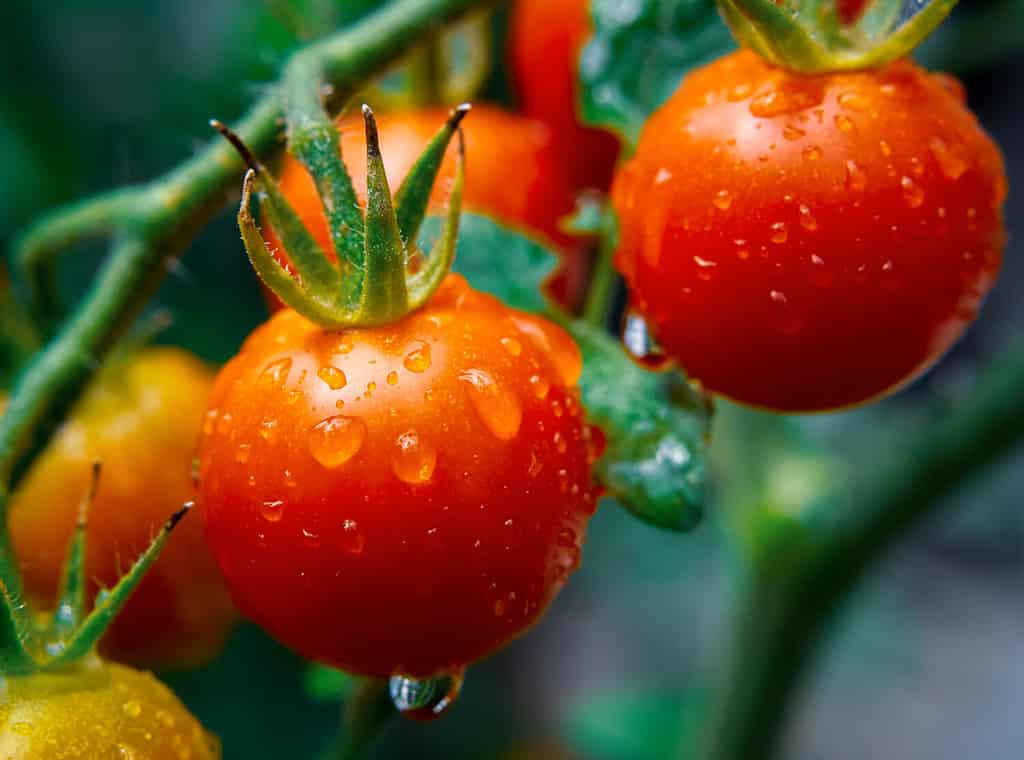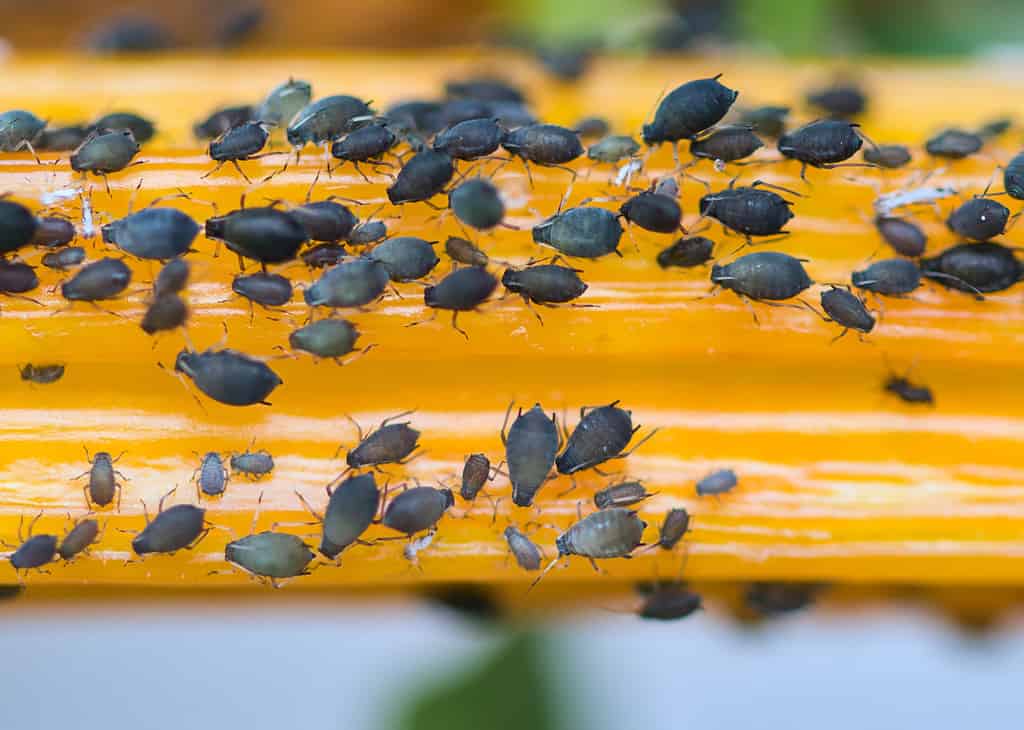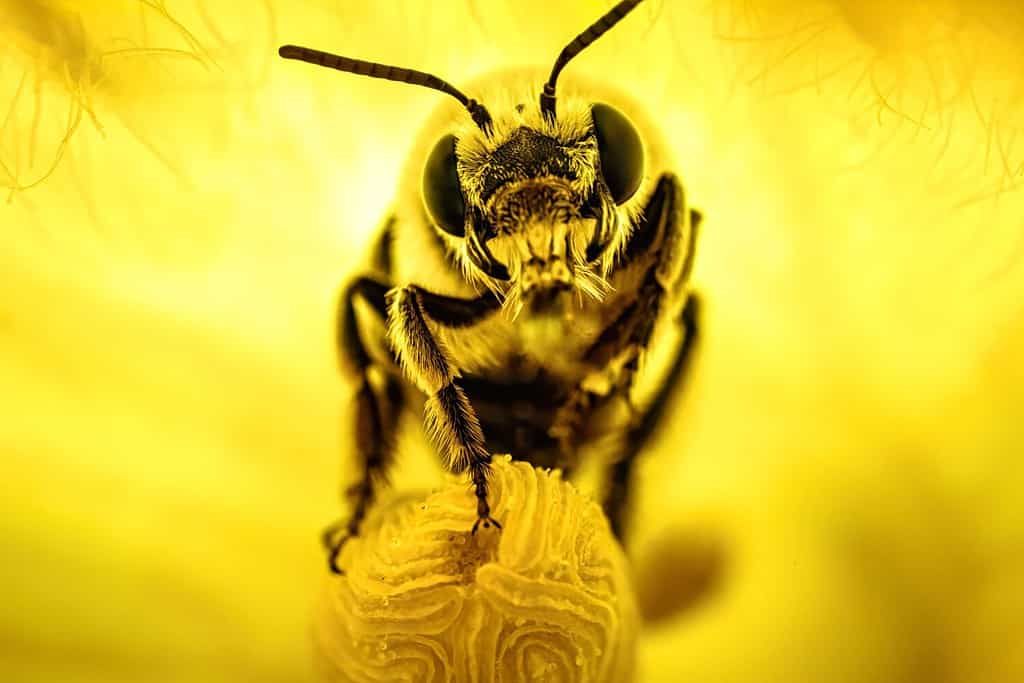If you’re reading this piece, it likely means that you’ve taken a look into your garden and begrudgingly accepted that those little flowers aren’t turning into anything else any time soon. It can be a huge disappointment to discover that your cherry tomatoes didn’t grow throughout the season, especially so late into it. But, what probably frustrates you the most is that the reason why your crops failed is still a mystery to you.
Lucky for you, we’re here to dive into five of the most common reasons why those cherry tomatoes didn’t grow. Some of the items might seem a bit obvious, and some might be things you’ve never heard before. In any case, the best way to solve a problem is by the process of elimination. As we go down the list, deeply consider each potential situation and evaluate whether or not it’s applicable to you and your garden. By the end, you’ll be certain to know where things went wrong in this year’s tomato harvest.

1. Inadequate Sunlight

Cherry tomatoes need upwards of eight hours of sunlight per day.
©Graham Corney/Shutterstock.com
This might seem like a day-one lesson, but the importance of proper sunlight for plants cannot be understated. A cherry tomato plant, in particular, needs six to eight hours of time in the sun every day. This can be quite a high expectation for those who live in shadier states or even just a shady area within a neighborhood. Even if you think that your tomatoes have gotten enough sunshine, here are some things that you should take into consideration!
Are There Objects Obstructing The Sunlight?
Your garden might generally be quite sunny, but what about the specific spot that your cherry tomatoes didn’t grow in? Make sure to look closely and see if there are any shadows. Things like lawn furniture or children’s playsets can be large enough to obstruct the sunlight from shining onto your plants. This may also be the case if you notice that only some of the plants aren’t growing as opposed to all of them.
Do You Use A Grow Light?
If you don’t use a grow light, then you might want to start. Plants that don’t receive enough light aren’t ever going to grow, but the good news is that the plants can be tricked into thinking that artificial light is actually from the sun! An investment in an affordable grow light can help ensure that those cherry tomatoes grow in no time.
2. Poor Soil Quality

A healthy pH balance for soil housing cherry tomatoes is between 6.0 and 6.8.
©Shannon Birchler/Shutterstock.com
Something that can be easily forgotten when considering a plant’s failure to grow is its soil. For your cherry tomatoes to grow properly, it’s recommended that their soil has a pH balance of 6.0 to 6.8. This ensures proper nutrition absorption and aids in facilitating root growth.
When soil is poor in quality, it can lead to root rot and oxygen deficiency. You’ll notice that this is a problem when some of the telltale signs, such as yellowing leaves and small fruits, begin to arise. If you’ve deduced that poor soil quality is the reason for your cherry tomatoes’ lack of growth, there are a few ways to improve it.
You can add organic matter, such as compost, to improve soil drainage. If that doesn’t help, you can also use raised beds or containers. If you use well-rotted manure or organic compost, you can help enrich the soil with well-needed nutrients. If there’s a specific issue with pH, a handy trick is knowing that you can use lime to raise the pH balance or sulfur to lower it.
3. Lack of Proper Watering

Underwatering and overwatering your plants can be equally as harmful overall!
©iStock.com/MaYcaL
The tricky part about watering is that there’s a double-sided limit. If you overwater your cherry tomatoes, it can be just as harmful as watering them too little. A good rule of thumb for watering is to give them 1-2 inches per week and adjust this as needed based on the amount of rainfall and the temperature outside. A little-known trick is to make sure you’re watering the soil instead of the leaves, as watering the leaves can lead to some nasty diseases!
Some common signs that your plant has been overwatered is that the leaves have begun to yellow and wilt despite wet soil. There might also be some mold or fungal growth on the plant, but generally, overwatering will make it look very dull and unenthusiastic. On the other end, underwatering has similar signs. Wilting leaves, cracking soil, and slow growth are all signs of this. In a pinch, another way to tell that your tomatoes have been underwater is that the bottoms will turn brown.
4. Unsolved Pest or Disease Problems

Aphids are common offenders when it comes to weakening your tomato plants!
©iStock.com/Ewa Saks
When your cherry tomatoes experience unwanted guests, whether those be physical or bacterial, trouble is bound to start brewing. Pests and diseases are obviously two very different things, but in the end, refusing to combat either of these pesky problems can result in an unfortunate end for your plant. Here are some quick prevention and treatment strategies for both of these problems:
Pest Prevention
- Make sure you know the signs of pest presence and are able to identify the most common offenders. These include aphids, which are small sap-sucking insects, and tomato hornworms, large green caterpillars that will devour large portions of your precious plant.
- Use organic methods like introducing beneficial insects. For example, aphids hate ladybugs, but the ladybugs won’t harm your plant!
- When necessary, you can bring out the big guns. Insecticidal soap can work quite well in a pinch. The goal is to identify and eliminate the problem as quickly as you can!
Disease Prevention
- Much like with pests, identification is key. The most common infections for tomatoes are fungal diseases such as tomato blight and things like Fusarium and Verticillium wilt.
- Ensure that you’re conducting proper crop rotations and plant spacing to prevent buildup in your soil. This also helps keep infected plants from interacting with safe ones.
- If you continue having these strokes of bad luck with plant illness, consider growing disease-resistant varieties of tomatoes instead of traditional ones.
5. Pollination Issues

If you find a way to attract pollen-spreading insects like bees to your plant, then they should be able to get the job done!
©Joseph Burdick/Shutterstock.com
The idea of pollination issues within a cherry tomato plant can seem confusing. That’s because tomatoes are actually self-pollinating plants, each flower containing both the male (stamen) and female (pistil) parts. Pollination occurs when pollen from the stamen reaches the pistil for fertilization and fruit production. This process works great in theory, but in actuality, there are a lot of external factors that can contribute to poor pollination.
When this process doesn’t properly occur, the flower of the tomato plant will fall off without producing any fruit. This can happen for a number of reasons, primarily due to unfavorable weather conditions or a lack of pollinating insects. When the pollen moves insufficiently, any attempt at the process becomes futile.
To encourage natural pollination, plant some flowers nearby. This can attract bees and any other insects that might be beneficial to the cause. If natural pollination doesn’t happen, no sweat! You can gently shake the plant to spread pollen or even use a small brush to manually push the pollen from the stamen to the pistil. As long as your plants are well-watered and healthy, pollen production should be simple and natural for your little guys.
Treat This as a Learning Opportunity
Far too often do gardeners, primarily those new to the practice, blame themselves for their plant’s lack of growth. This can lead to reduced confidence regarding their skill, or even worse, making them doubt their ability to move forward with gardening. Instead of letting these bad feelings manifest into something worse, take a moment to consider how far you’ve come.
One bad summer doesn’t mean a general lack of gardening talent. Just because your cherry tomatoes didn’t grow this year doesn’t mean they won’t in the next! Use what you’ve learned from the experience, hopefully including the items on this list, to better yourself next time planting season rolls around. After all, practice makes perfect!
The photo featured at the top of this post is © Shannon Birchler/Shutterstock.com
Thank you for reading! Have some feedback for us? Contact the AZ Animals editorial team.







